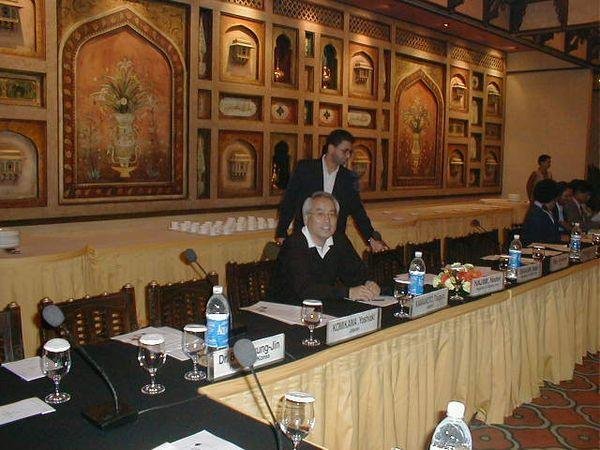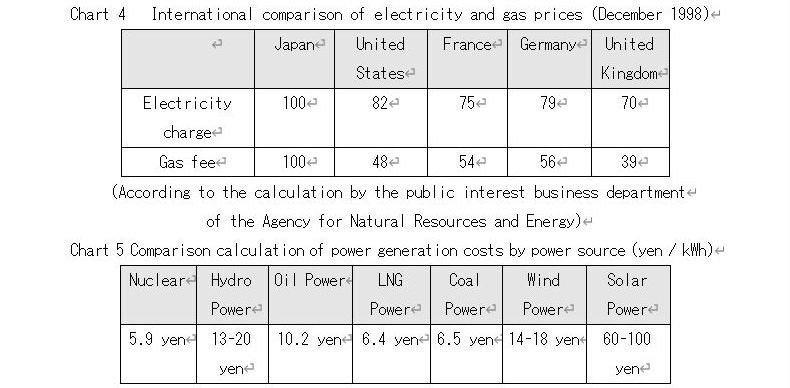
省エネ大賞受賞技術開発の軌跡 (24) Trajectory of Energy Conservation Grand Prize-winning Technology Development (24)
1.4・5 石炭、石油、原子力、新エネルギー (2) 日本の現状 (2002年時点)
先に述べたように私は多くの他のアジア諸国の参加者と一緒にワークショップに参加しました。更に私はSetsuden-mushiの技術資料を出席者に配布しパワーポイントを使った資料で追加説明や質問に答えながら「節電虫」はすぐにでもできる省エネルギー技術として参加者にPRしました。

以下は会議・ワークショップ参加の事前準備として日本のエネルギー事情を児美川氏がまとめました。そしてそれを私が英語翻訳し持参して日本の実情紹介をしました。
____________________________
国別報告書(日本) COUNTRYPAPER(JAPAN)
1.序文 Introduction
日本は、南北に約3,000kmに渡り細長く伸びた島国で、国土面積は約40万k㎡です。人口は約13,000万人で、東京、大阪などの大都市に集中しています。気候は、南北で大きく異なるものの、概ね、温暖湿潤気候に区分され、ほぼ中央に位置する東京の年間平均気温は約15℃です。(1月=5.2℃、8月=27.1℃)
東京では、四季がはっきりしており、冬は年に1,2回は雪が降りますし、逆に夏は非常に蒸暑く、ほとんどの建物は空調されています。
2.国内使用エネルギー形態 Forms of energy used in the Country
日本のエネルギー利用の中心は石油です。石油の利用率はピーク時の8割近い水準からは下がりました。しかし、石油は依然として全体の約半分を占め、自動車燃料、化学原料及び鉱工業などに広く利用されています(図表1参照)。一方、1970年代のオイルショック以降に石油への依存度を低くする政策が進められました。その結果として発電分野では原子力や天然ガス火力の比率が高くなっています(図表2参照)。(日本は天然ガス利用の97%を海外からの輸入に頼っており、そのすべてをLNGとして輸入しています。)
日本は京都議定書で約束したCO2削減目標に向けて、新エネルギー(太陽光発電、風力発電、バイオマス、廃棄物熱利用など)の導入も積極的に進めています。1999年度実績では新エネルギーの供給割合は1次エネルギー供給全体の1.2%にすぎませんが、2010年にはそれを約3倍に増やす目標を立てています(図表3参照)。

3. 国内エネルギー価格 Cost of Energy in the Country
最も身近な料金についてみると、電気とガス料金は欧米先進国と比較して高くなっています(図表4参照)。また、石油の精製コストは欧米と比較して操業費、維持修繕費において我が国の方が約1.5倍前後割高になっています(1996年。出所:(財)石油産業活性化センター調べ)。石炭に関しては一般炭の国内炭平均価格は平均輸入炭価格の約3倍(平成9年度)となっています。このように総じて我が国のエネルギー供給は相対的に高コストです。
次に、環境に優しいエネルギーとして期待されている新エネルギーの発電コストを既存の主力電源と比べてみます。現状の試算ではコスト面ではかなり大きな開きがあります(図表5参照)。

4.省エネルギーのための政府施策 Government Initiatives for Energy Conservation
エネルギーに関する日本政府の方針は、“3つのE”の実現に集約されます。Energy Security(エネルギーの安定供給)、Economy Growth(経済成長)、Environmental Protection(地球環境の保全)の3つを同時に実現する施策です。
エネルギーの安定供給の観点からはエネルギーの自給率の向上、輸入先の分散化、エネルギー備蓄の促進などが必要です。経済成長のためにはより一層のエネルギーコストの低減に向けた取り組みが必要とされます。
しかし、その中で当面の一番大きな課題は3つ目の地球環境の保全です。特に地球温暖化対策として掲げられた2010年に向けたCO2の排出量削減が急務です。政府は1998年に地球温暖化対策推進本部(本部長:小泉純一郎首相)を設置し、すでに積極的に対策に取り組んでいます。現在、政府は①省エネルギー対策、②新エネルギー対策、③発電分野における燃料転換および原子力の増設を3つの柱として取り組んでいます。
5. 規 制 Regulatory Issues
1999年に改正した省エネルギー法(エネルギーの使用の合理化に関する法律)が効果を上げています。この法律はエネルギーconsumptionの大きい工場や事業所に省エネ対策や点検を義務づけています。また、この法律は省エネ機器の普及を促進するために家電製品や自動車にトップランナー基準方式を適用し機器の効率改善を促しています。(この方式では機器のエネルギーconsumption効率が現在商品化されている製品のうちの最も優れている機器の性能以上の水準に設定されます。そしてこの方式はそれを達成基準値として目標年度までに基準達成することをメーカーに義務づけます。)
特にトップランナー基準はエアコン、テレビなどの家電製品や自動車などを対象としました。メーカーの開発努力の結果としてすでに多くの新製品が基準をクリアしました。そして目標年を待たずにその基準が達成できました。(2003年以降はその基準の目標年は品目によって異なります。)政府は今後さらに対象機器を拡大し、より一層の機器の効率改善を図ることを計画しています。
6. 問題/障壁 Problems / Barriers
電力自由化など規制緩和が進み景気の低迷が続いています。そして近年、日本国内のエネルギー価格は低下傾向です。その状況下で省エネルギー技術の導入は非常に難しくなっています。さまざまな省エネルギー技術がすでに実用化されています。しかしそうした技術導入は依然として高い費用がかかります。その負担を企業やconsumption者が喜んで受け入れるかどうかは非常に疑問が残ります。節約したランニングコストで初期コストを回収することが難しくなっています。どれだけそうした技術が普及するかが今後の省エネ対策の成功のカギとなります。しかしエネルギー問題に総合的に取り組むためにはエネルギーの創造と節約の両面に私たちは取り組まなければなりません。発電と省電のためには補助金だけでなく啓発活動を含めた政府の役割が大切です。
一方、魅力的な新技術を搭載したトヨタ自動車のプリウス(ハイブリッドカー)は高価格にも関わらず大変な売れ行きとなりました。市場は価格だけでなく環境性能をも評価しました。さらに、2003年には燃料電池自動車の市場投入が期待されています。魅力的な省エネルギー技術が価格の壁を破って普及する可能性は十分あります。
環境性能については表面的な環境性能だけでなく商品が製造され廃棄されるまでの全過程における環境影響が評価(LCA)されなければなりません。そしてその情報を開示することで持続性のある環境共存社会が構築されなければなりません。
続く
1.4.5 Coal, oil, nuclear power, new energy (2) Current situation (as of 2002) in Japan
As I mentioned earlier, I attended the workshop with many other participants from Asian countries. I myself distributed the technical data of Setsuden-mushi to attendees and publicized the Setsuden-mushi to the participants as an immediately implementable energy saving device while making additional explanations and answering questions with the data using PowerPoint.
The following is a summary of energy situation in Japan by Mr. Komikawa as a preparation for attending the conference and workshop. And I translated it into English from Japanese and brought in to introduce the actual situation in Japan.
_________________________________
COUNTRY PAPER (JAPAN)
1. Introduction
Japan is an island country about 3,000 km from the north to the south, whose land area is about 400,000 km2. It has a population of approximately 130 million concentrated in large cities such as Tokyo and Osaka. Although the climate varies greatly from north to south, it is generally classified as a warm and humid climate with the average annual temperature of about 15 ° C in Tokyo located in the center. (Jan = 5.2 ℃, August = 27.1 ℃)
In Tokyo we have four seasons clearly. It snows once or twice a year in winter and on the contrary, it is extremely hot and humid in the summer. Most buildings are air-conditioned.
2. Forms of energy used in the Country
Oil is the center of energy use in Japan. Oil utilization has fallen from nearly 80% of the peak level. However petroleum still accounts for about half of the total and is widely used for automobile fuels, chemical raw materials, mining and other industries (see Figure 1). On the other hand, after the oil crisis in 1970s, policies to reduce the dependence on oil were promoted. As a result the ratio of nuclear power and natural gas thermal power is increasing in the power generation field (see Figure 2). (Japan relies on 97% of its natural gas utilization from overseas, all of which is imported as LNG.)
Japan is actively promoting introduction of new energies (solar power generation, wind power generation, biomass, waste heat utilization and etc.) toward the CO2 reduction target promised by the Kyoto Protocol. In FY1999 the supply ratio of new energy was only 1.2% of the total primary energy supply, but in 2010 we have set a target to triple it (see Chart 3).

3. Cost of Energy in the Country
Looking at the most familiar charges, electricity and gas charges are higher than those in the developed countries like the US and Europe (see Chart 4). In addition, petroleum refining costs are about 1.5 times higher in Japan in operating and maintenance costs than in the US and Europe (1996. Source: Petroleum Industry Revitalization Center). Regarding coal, the average domestic coal price for steaming coal is about three times the average imported coal price (FY 1997). As showed, Japan's energy supply is relatively expensive.
Next, let's compare the power generation costs of new energy, which is expected as environmentally friendly energy, with existing main power sources. According to the current estimation, there is a considerable difference in cost (see Figure 5).

4. Government Initiatives for Energy Conservation
The Japanese government's policy regarding energy is concentrated on the realization of "3 Es", which are Energy Security (stable energy supply), Economy Growth and Environmental Protection (conservation of the global environment). These three should be simultaneously realized.
From the perspective of stable energy supply, it is necessary to improve the energy self-sufficiency rate, diversify import sources and promote energy storage. For economic growth, efforts to further reduce energy costs are needed.
However, the biggest issue for the time being is the third one, conservation of global environment. In particular, there is an urgent need to reduce CO2 emissions toward 2010, which was set as a measure against global warming. The government established the Global Warming Countermeasures Promotion Headquarters (General Manager: Prime Minister Junichiro Koizumi) in 1998 and is already actively working on countermeasures. Currently, the government is working on three, which are (1) energy conservation measures, (2) new energy measures and (3) fuel conversion and nuclear expansion in the power generation field.
5. Regulatory Issues
The Energy Conservation Law revised in 1999 (law regarding rationalization of energy use) is effective now. This law obliges factories and offices with high energy consumption to implement energy conservation measures and inspections. The law also applies the Top Runner standard method to home appliances and automobiles to promote the spread of energy-saving equipment and promotes the efficiency improvement of equipment. (In this method, the energy consumption efficiency of the equipment is set to a level higher than the performance of the best equipment among the products that are currently commercialized. And this method uses it as the achievement standard value and requires manufacturers to achieve it by the target year.)
The top-runner standard was targeted at home appliances such as air conditioners and TVs and automobiles. Many new products have already passed the standards as a result of the manufacturer's development efforts. And they achieved that standard without waiting for the target year. (After 2003, the target year of the standard varies depending on the item.) The government plans to further expand the target equipment and further improve the efficiency of the equipment.
6. Problems / Barriers
Deregulation such as electric power liberalization is progressing and the economic downturn continues. And in recent years, domestic energy prices have been declining. Under such circumstances, the introduction of energy saving technology is extremely difficult. Various energy-saving technologies have already been put to practical use. However, such technology introduction is still expensive. Whether companies or consumers will be willing to accept the burden remains highly questionable. It is difficult to recover the initial costs by the saved running costs. How to make these technologies used will be the key to successful energy-saving measures in the future. However, in order to tackle energy issues comprehensively, we must tackle both the creation and saving of energy. For power generation and power saving, the role of the government, including not only subsidies but also enlightenment activities, is important.
On the other hand, Toyota's Prius (hybrid car) equipped with attractive new technology has sold very well despite its high price. The market valued not only price but also environmental performance. Furthermore, it is expected that fuel cell vehicles will be launched in the market in 2003. There is a good chance that attractive energy-saving technologies will break the price barrier and become widespread.
Regarding environmental performance, not only the surface environmental performance but also the environmental impact (LCA) of the entire process from manufacturing to disposal of the product must be evaluated. And by disclosing that information, a sustainable environmental coexistence society must be established.
To be continued
